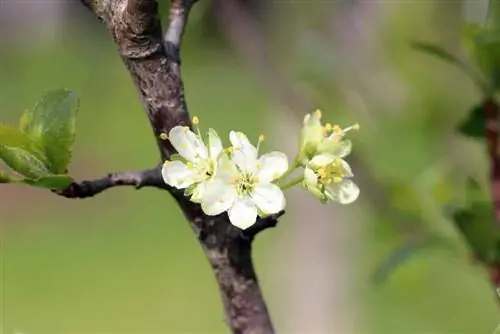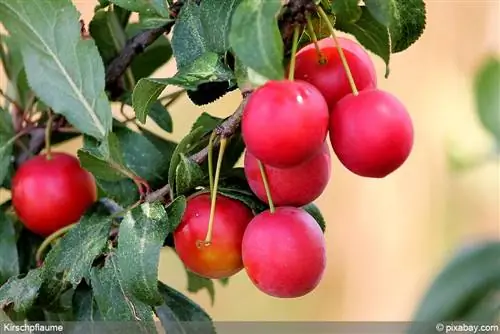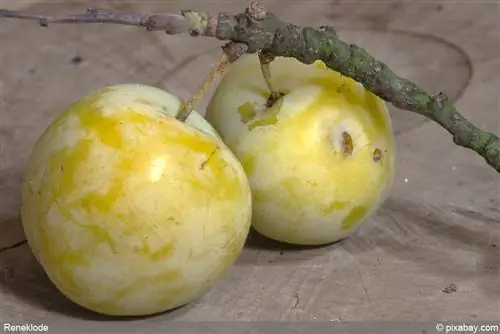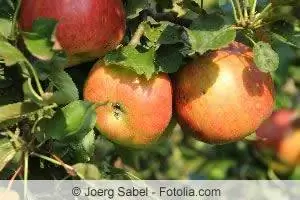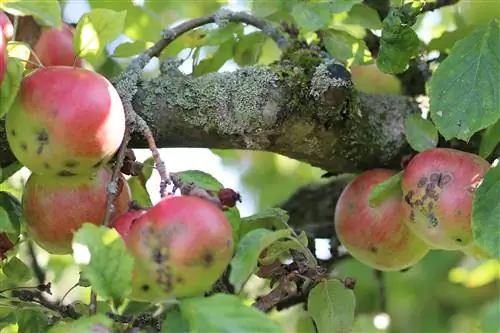- Author admin [email protected].
- Public 2023-12-17 03:39.
- Last modified 2025-01-24 12:45.
The plum tree, Prunus domestica, is a species of the genus Prunus, from the rose family (Rosaceae). The species Prunus domestica includes all those fruits that give rise to conversations every year like: “What is the difference between a plum and a plum?” Although resourceful contemporaries like to throw in a few renecludes and mirabelle plums at this point. First of all, there are differences, but all of these subspecies belong to the plum plant species and have roughly the same requirements when it comes to care.
Location
When people talk about “easy to care for”, then it should be noted right away that a plum tree is easier to care for the more perfectly the location is adapted to its conditions. Plums love the warmth, after all their ancestors come from the Near East and reached Central Europe via the Mediterranean region.
The plum tree doesn't like windy and frosty places at all. The best location is sunny, south-facing and protected from the wind, preferably in front of a house wall, hedge or wall. When considering the location, it should also be taken into account that this area is not particularly exposed to late or early frost. Any places in the garden that are particularly high or low should be avoided. Because the plum tree can neither tolerate drought nor waterlogging.
Substrate & Soil
With adequate soil quality for the plum tree, you are already practicing good he alth care and ensuring a rich harvest. If the garden soil in the planned location is clayey and compacted, you will not be able to avoid generously digging out the soil there and mixing it with compost, sand and clay according to your requirements. In extreme cases, drainage must be installed. Because, although the plum tree likes it moist, it cannot tolerate waterlogging.
The soil should ideally show the following qualities:
- nutrient-rich
- humus-rich (ability to store water, not accumulate it)
- calcareous
- Mixture of: garden soil, compost, some clay and sand
Pouring
This chapter is quite a short one. Because the demands for additional watering are very low. An exception is the first year after the tree was planted.
Of course, the plum tree experiences extreme weather conditions from time to time throughout its life. For example, particularly hot and dry summers or long periods without rain, then watering is necessary.
It is best to give plenty of water in the evening. Rainwater or stale tap water is best suited for this. It's not a big deal if you reach for the water hose every now and then. But as soon as the soil shows chalky, white spots on the surface, you need to take action. It's best to remove the top layer and mix it with humus-rich soil.
Fertilize
The plum tree is also quite undemanding when it comes to fertilizing. You can only help with fertilizer or compost if the garden soil is demonstrably low in nutrients. The following fertilizers are well suited:
- Complete liquid fertilizer for fruit trees
- well-ripened compost (organic)
- Dung, stable manure (organic)
- moderate administration of horn meal
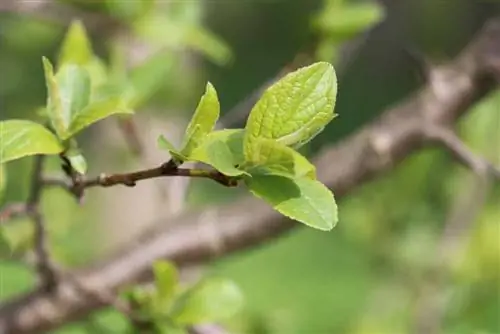
Young trees tolerate fertilizer every year. After the fifth year, fertilization every two years is sufficient. The tree is particularly sensitive to too much nitrogen. This can be recognized by rapid shoot growth. Leaves and flowers are not as stable and the tree becomes more susceptible to disease.
Mulching in spring is a good measure for a balanced moisture balance. On this occasion he also gets a few extra natural nutrients.
Tip:
If the plum tree is on the lawn, make sure to leave out the area of the ground disc when fertilizing the lawn. These fertilizers are very high in nitrogen and have a negative effect on the plum tree.
Cutting
If you want your plum tree to have a beautiful crown and a rich harvest, you can't avoid regular pruning. Pruning is only avoided in the first year after planting.
Basically, it is better to cut it gently every year than to cut it radically every few years. As with all fruit trees, the best time for pruning is late autumn or early spring.
Get to work with sharp, clean tools:
- dead, dried, injured branches
- branches growing criss-cross (crown thinning)
- outer shape of the crown, round-oval, harmonious
- Short leading shoots that go off to the side by a third
You can also take this opportunity to treat the trunk to some care. A rough, barky and mossy trunk is then thoroughly processed with a wire brush. Then, as a further protective measure against pests, a ring of lime or a special tree paint is applied.
Tip:
If you want your plum tree to be bushy, like a bush, leave saplings on the ground. But not more than five or six.
Plants
Once the right type of plum has been found for the garden and the location has been determined, it's time to plant. The best time to plant is late autumn. It is always said that you can plant container goods all year round, but autumn is also the best time for planting. This gives the offspring time to develop their roots until spring.
A radius of approximately one meter fifty around the tree should first be cleared. On this occasion you can improve the quality of the soil with compost, manure or gravel, depending on the deficit.
Dig a correspondingly deep planting hole and insert the small tree. Only deep enough that the finishing point still looks out a few centimeters above the ground. If the plant is still very young, it is best to put it in the ground at the same time with a support stake on the side. This way the roots are not damaged.
After inserting, put the excavated material back in. It is advantageous to mix this soil with compost beforehand to promote growth. The cavities are filled with a slight shaking up and down and finally the earth is carefully trodden on. To prevent it from drying out, it is recommended to mulch the tree disc all around.
Then put the small plum tree properly under water. Water regularly and thoroughly throughout the first year. The substrate must not be permanently moist. The roots need an incentive to root themselves deep into the ground. Keep the site free of weeds and other plants, especially in the first year (radius 1-1.5 m).
Propagation
If you like experimenting in the garden, you can try propagating your plum tree. This works through
- Sowing the seeds
- Propagation by shoots
- Refining
The latter option is more for particularly green thumbs. But anyone can have the confidence to propagate through a seed or shoot.
The core of the plum is cleaned and slightly cracked. The plum is a cold germinator. A small pot with potting soil and the core is best spent outside during the cold winter or in the refrigerator for a few weeks. Then slowly get used to the light and warmth and wait eagerly for the first cotyledons.
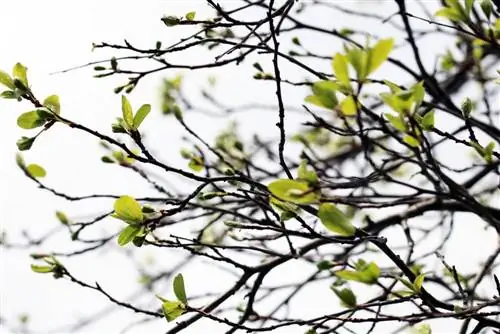
For shoot propagation, it is sufficient to occasionally walk around the tree and dig up the natural shoots that come out of the ground on their own. Then it's best to put it in a bucket first. The larger and undamaged the roots, the better. Keep the fresh shoot well moist, fertilize and protect it from cold and wind.
Varieties
It's worth looking into the different varieties before buying a plum tree. Important criteria, in addition to appearance and tasty fruits, should be the different requirements, robustness and type of fertilization. If you have a small garden with space for just one plum tree, you should use a self-pollinating method. Basically, plum trees are cross-pollinators and the yield of these species is higher than that of self-pollinators.
First of all, a brief explanation of the differences between plums, plums and the like seems helpful. The cultivated plum, Prunus domestica, is a species of plant in the genus Prunus, with over 200 species. The plum is a hybrid of blackthorn and cherry plum. This resulted in seven well-known subspecies, which often cause name confusion:
Plums
Plums are usually smooth, large and round with a groove. The flesh is juicy, sweet and often difficult to separate from the stone. They are available in the colors blue, red, purple and almost completely black.
Plums
Plums are dark blue, purple coated with a frost-like white coating. They are slightly smaller and more oval than plums. The pulp is firmer and drier and the core can be easily removed.
Noble Plum
There are two varieties here. The real sweet plum and the Reneklode. The Reneclodes, also known as ringless, are spherical, usually green-yellow and quite sweet. The real sweet plum is also spherical and not quite as sweet. They are available in different shades of red and blue.
Creeping Plum
The small, spherical fruits of the creeping plum, also known as oat plum, are offered for fresh consumption. It is occasionally used to make oil and as a basis for fruit brandies. The tree itself is often planted as a hedge or used as a base for fine plum varieties.
Zibarte
The Zibarte is a small tree with small, round, mostly black fruits that look like sloes. They are mainly used for fruit brandies.
Mirabelle
The fruits are small, spherical and yellow. The pulp comes away easily from the stone and is very sweet. Mirabelle plums are also largely grown for the production of spirits of the same name.
Spilling
The Spilling, Spille or Katharinen plum grows mainly in southern Europe. The fruits are similar in taste to mirabelle plums. They are usually bright orange, round and have a high fructose content.
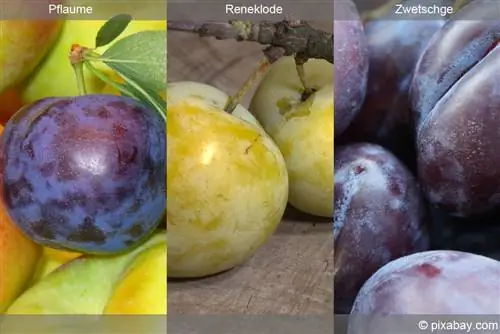
If you plant a plum as a sweet tree for the garden, you will usually choose a variety from the plum or plum varieties. The greatest variety is found in plums; they are by far one of the most popular plums. Among the plum species there is only one that is resistant to Sharka.
Some varieties with the most important characteristics briefly presented:
- ‘Tophit’: plum; large fruit; low susceptibility to disease
- ‘Haganta’: plum; sweet, large fruits; low susceptibility to disease
- ‘Queen Victoria’: particularly large fruits;
- Ontario plum: self-pollinator; hardly susceptible to Sharka; large, yellow fruits.
- Large Green Reneclaude: high quality Reneclaude; mostly green-yellow, very sweet and juicy; Cross-pollinators
- ‘Hanita’: plum; rich yield; hardly susceptible to illness; robust; Cross between 'President' and 'Auerbacher'
- ‘Katinka’: plum; tasty, sweet fruits
- ‘Tegera’: plum; large fruits; self-fertilizing; early ripe, big yield
- ‘Jojo’: plum; resistant to Sharka; Self-pollinator
Diseases & Pests
Even if the plum tree is considered relatively robust, it is sometimes not spared from diseases and pests. If you offer it favorable and he althy conditions, through an ideal location, with good soil quality and optimal water and fertilizer, the risk of this has already been significantly halved. Even a regular, thorough inspection can usually prevent the greatest damage.
Plum moth
An infestation with plum moth larvae can be recognized by small drill holes in the fruit. The best protection is to make the garden as attractive as possible for natural predators such as songbirds and parasitic wasps. Pheromone traps can be used to catch the moths and thus reduce their number.
Monilia Mushroom
An infestation with the Monilia fungus can be recognized by the dry tips of the branches and later by the rotting fruits. Fungal diseases can only be effectively combated with fungicides. In the early stages it is still sufficient to radically remove and destroy the affected parts of the plant.
Plum sawfly
The larvae of the plum sawfly cause considerable damage by eating the ovary. Later the fruits are filled with feces and fall off unripe. The larvae overwinter in the soil around the tree. There is currently no effective protection against the plum sawfly. The population can be reduced using white glue boards that are hung in the tree shortly before flowering. Infected fruits must be picked up and destroyed.
Plum Rust
The spores of this fungus infect the leaves of the plum tree in May. There are brown spore spots on the underside of the leaves. By the end of summer they have spread across the entire tree and the affected leaves fall off. Plum rust is particularly common in wet, rainy summers. Only treatment with appropriate fungicides helps against severe infestation.
Scharka disease
Sharka disease is a viral disease. In spring you can recognize a possible infestation by light green rings on the leaves and the tissue dies. The fruits develop pock-like indentations and the flesh changes color and becomes rubbery. The plums fall off prematurely. In this case, one can only hope that the plum tree is never affected by this virus, because it is a dangerous and reportable disease. It can then be made a requirement that the tree be completely removed and destroyed.
Conclusion
If you want to enrich your garden with a fruit tree, a subspecies of Prunus domestica is a good choice, depending on your taste. If there is not enough space for several of its kind, the newer varieties are recommended. The self-pollinating species also produce an attractive fruit cluster as a “single tree”. Many new species are also quite robust and can tolerate less than perfect conditions.

